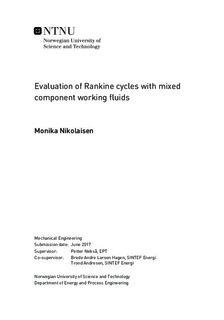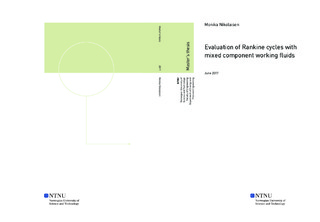| dc.description.abstract | The thesis evaluates the performance of Rankine cycles with mixed component hydrocarbon working fluids, or hydrocarbon mixtures. The objective is to compare mixtures with pure fluids on the basis of the same total heat exchanger (HX) area. This is achieved through further development and application of a three-step cycle optimization model developed in the project work, which calculates the maximum work output for a pre-defined value of total HX area. The model simultaneously calculates the optimum distribution of HX area between the condenser and the heat recovery heat exchanger (HRHE).
A literature review is performed that studies heat transfer and pressure drop of working fluid mixtures through horizontal smooth tubes to evaluate and implement improved correlations. The literature review demonstrates that several methods are available for predicting heat transfer coefficients (HTCs), and that a method by Bell and Ghaly (1973) is most common for condensation, and a method by Thome (1996) is most common for evaporation.
The cycle optimization model is further developed though implementation of new heat transfer correlations better suited for hydrocarbons. A more comprehensive estimation of overall HTC is made, and the option of internal heat exchanger (IHX) is included. A more detailed working fluid comparison is made through the study of optimum heat exchanger designs, including the distribution of condenser and HRHE area for different values of pre-defined total HX area. The specific working fluid affects HX design in terms of pinch points and distributions between condenser and HRHE area. Moreover, HX pressure loss is determined by working fluid overall HTCs and operating pressure, and the number of tubes and tube diameter is most affected by pressure levels.
Four cases are defined that represent present and future applications of Rankine cycle. Case 1 and 2 consider a heat source at 100℃, with no lower limit on heat source outlet temperature. In case 1, the heat sink outlet temperature fixed and in case 2 it is allowed to vary. In case 1 and 2, butane, ethane and ethane (0.6/0.4) are studied. Case 3 and 4 consider a heat source cooled from 200℃ to 80℃. Case 4 differs from case 3 in that the optimization tool is given the choice to include an IHX, and does so if this contributes to an increased work output. In case 3 and 4, butane and butane-propane (0.6/0.4) are studied. For all cases, work output is maximized for different values of pre-defined total HX area.
Contrary to the case studied in the project work, the results for case 1 and 2 demonstrate that the hydrocarbon mixture has the potential to achieve significantly higher work output than the pure fluids for the same total HX area (up to 34 %). Variable heat sink outlet temperature allow small improvements in work output from case 1, and the improvement is greater for the pure fluids.
In case 3, the pure fluid achieves on average 3.7 % higher work output than the mixture. However, a working fluid screening demonstrated that other mixtures may have more potential in this case. With the inclusion of IHX, work outputs increases between 1.5 % and 11.6 % for the same total HX area, with increased potential for improvement at relatively high values of total HX area. In fact, the IHX was not included in the optimum solutions for lower-range values of area. Improvement with IHX was highest for the mixture, which enabled it to achieve the same levels of work output as the pure fluid. Despite the low potential of the mixture in this case, it may be more applicable for high values of total HX area than the pure fluid due to its relatively hgih pinch point temperatures.
A significant increase in work output can be achieved with increasing heat source temperature. For the heat source at 100°C, work outputs reaches around 25 kW for high values of total HX area. For a case studied in the project work with a heat sources at 150°C, work outputs reaches 50 kW, and for the heat source at 200°C in the current work, work output reaches 100 kW. | |

